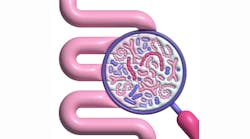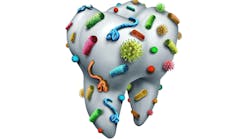You’ve heard the saying, first comes love, then comes marriage, then comes the prenatal care, birth plan, and carefully curated infant diet designed to establish and maintain a healthy microbiome. That is the saying, right?
The development of the human microbiome is a delicate and intricate story that, quite frankly, is still being discovered. However, the incredible nuances of scientific discoveries about the human microbiome and its influence on metabolic pathways and overall health provide a compelling narrative that has captivated researchers and begun to influence patient-centric care plans across the United States and around the world.
This article will unpack that story—to the best of current evidence’s ability—and the role of oral health practitioners in advocating for a supreme standard of care for themselves and their patients that actively integrates what we are beginning to learn about the microbiota and health.
The human microbiome story
Where did our personal micdrobiome begin, and how did we develop the complexities of the microbes that reside within us? As far as it is understood, the most diverse grouping of microbes resides within our gut, and the complexities of our gut microbiome began in utero. Factors such as our mother’s diet while pregnant, her antibiotic or drug usage, and her environmental exposures began to establish our gut microbiome. Additionally, our entrance into the world (vaginal versus cesarean) also deeply influenced the makeup of our microbiome.
It is believed that entrance via the vaginal canal, dense with high concentrations of various immunoglobulins and bacterial components such as health-producing Lactobacillus reuteri, results in a newborn’s microbiome consisting of a decrease in gram-negative bacteria and an increase in gram-positive bacterial counts within the gut.1
A sunroof approach (cesarean delivery) is said to influence a newborn’s microbiome, consisting of high concentrations of Staphylococcus and Streptococcus (both considered “bad boys”) as well as high concentrations of Enterobacter (not a bacteria a new mama wants her child to encounter) and lower concentrations of Bifidobacterium (a healthy bacteria) within the gut.
While we are being passed around a hospital room with family members breathing on us, our microbial abundance and diversity outside the womb begins. This diversity is influenced by our primary diet,2 including whether we were breastfed (particularly if we consumed Mom’s colostrum or the first breast milk a mother creates), as well as environmental exposures (e.g., exposure to water sources and dust), dietary influences, sex hormones, and use of antibiotics and/or antimicrobials, to name a few.
As germophobic parents lather up the hand sanitizer to limit exposure to bacteria, an even greater concern is if an infant develops a deficient microbiome, or one presenting with a highly dysbiotic environment (think playground bullies). These highly dysbiotic microbiomes will alter immune development, metabolism, and subsequently enteric nervous system development, paving the path for a lifetime of potential complications ranging from autoimmune disorders, obesity, and even autism.2
It is believed that the gut microbiome evolves until approximately age three (often the age of the first dental appointment), at which time it exhibits as that of an adult. However, the metabolites of these microbes are not fully functional yet, and this is where the battle of good versus evil will commence as we continue to shape the habits of our microbiome throughout our lifetime.
Research is still determining how powerful this understanding can be in total immune health and, more specifically, how treating the microbiome may be the missing link to establishing health and preventing disease for a lifetime.
The microbiome sets the tone
Previously, looking at the microbiome was seen as a holistic approach to health care, a common observation by Eastern medicine practices, or simply a “preventive” approach believed to have influences on overall health that were deemed mild at best.
Interestingly, research studies have observed the progression of health or disease as driven by the gut microbiome, most notably in sterile lab mice receiving various types of fecal transfers. Put simply, the introduction of a new microbiome via fecal transfer from different sources can establish health, propagate disease, or heal an otherwise diseased microbiome.
These studies have observed how sterile lab mice who receive a transfer of feces from obese human donors become obese, while lab mice who receive a transfer of feces from an underweight human donor become deficient in weight. This has been replicated with conditions beyond body mass index (BMI), citing studies that observed changes in conditions such as C. diff infection, inflammatory bowel disease, and even autism with a fecal transfer from a healthy donor (figure 1).3
As such, the active treatment of disease may be more specifically focused on the entire environment of the microbiome rather than simply ridding the body of bacteria. The “flushing” (no pun intended) of a microbiome with antimicrobials and antibiotics is no longer the extent of our duty (OK, that pun was intended) as clinicians. While it is well understood that debridement procedures are the first mode of addressing pathogenic bacteria in the oral cavity, perhaps preserving a healthy microbiome can become a solid number two (final pun, I promise).
An alternative to fecal transfers
A small portion of readers may now have piqued interests and are currently researching how they can explore a “prophylactic fecal transfer” of their own, as the rest of the practicing clinical population is wondering, are there alternatives to delivering a fecal transfer? Are there other ways to introduce an intentional microbiome into the body?
The answer is kind of.
Specifically, research has both recognized that the mouth is the entryway to the gut and that the management of oral disease may demonstrate a positive influence on gut health—this is the study of the oral-gut axis. What’s more, research has studied microbial transmission from the oral microbiome to the gut microbiome as the two largest microbial ecosystems within the body.4
If health care can find a way to introduce a healthy microbiome from the top down, perhaps we can influence health simply by encouraging the healthy bacteria to predominate.
Remember our birth story and the unique data we’ve learned about how a vaginal delivery dense with L. reuteri will permit the gut microbiota to control gram-negative bacteria and encourage gram-positive bacterial diversity? Here’s where it gets really interesting.
Understanding health-producing bacteria
Despite being born via cesarean, babies who were introduced to L. reuteri at two weeks to four months were able to modulate their gut microbiota toward the community found in vaginally delivered infants.5 While L. reuteri is a well-studied bacterium that is indigenous to the human gastrointestinal tract, it is currently present in less than 1% of individuals.1
Appreciated for its specific ability to reduce inflammation (strain ATCC PTA 5289) and its antimicrobial activity (strain DSM 17938), isolated strains of L. reuteri have been introduced into oral probiotics and offer compelling evidence to corroborate its clinical efficacy.
Adherence and competition
A key concern when it comes to oral health begins with the ability of bacteria to adhere to surfaces and sites within the oral cavity. L. reuteri strains can adhere to various surfaces within the oral cavity when the formation of biofilm begins; they colonize the oral cavity and essentially compete with periodontal pathogens (and win) for adhesion sites and nutrients, thus starving pathogenic bacteria.6
Reducing inflammation
Additionally, strains of L. reuteri bacteria can reduce the concentration of inflammatory cytokines within the crevicular fluid while reducing bleeding tendency within the gingival sulcus.7
Producing antimicrobials
Incredibly, L. reuteri is an efficient producer of reuterin, an antimicrobial substance that is both capable of bactericidal qualities and can inhibit a wide array of gram-negative, anaerobic bacteria. As such, the swift release of reuterin inhibits the development of periodontal pathogens.8
Enhanced mucosal barrier
A key concern of pathogenic oral bacteria is their ability to disrupt the epithelial barrier function, which allows them to leak into the bloodstream. L. reuteri tightens the junction proteins between the epithelial cells, demonstrating protective properties for the mucosal membranes.9
Modification of the oral microbiome
It has been well understood that oral disease-producing bacteria can influence the development of systemic diseases. The role of the oral health-care practitioner in identifying, treating, and maintaining inflammatory diseases of the periodontium has never been more recognized, discussed, and scrutinized.
As research continues to identify key ways that dentistry is involved in the control of systemic disease, perhaps the deeper questions regarding the therapy of periodontal diseases should be: Are my scalers enough? Will antimicrobials truly pave the way for overall health?
Or, perhaps to ensure a “happily ever after” ending for our patients, we may consider a new approach to influencing the microbiome through the integration of health-producing bacteria.
Editor's note: The article appeared in the August/September 2024 print edition of RDH magazine. Dental hygienists in North America are eligible for a complimentary print subscription. Sign up here.
References
- Mu Q, Tavella VJ, Luo XM. Role of Lactobacillus reuteri in human health and diseases. Front Microbiol. 2018;9:757. doi:10.3389/fmicb.2018.00757
- National Academies of Sciences, Engineering, and Medicine; Division on Earth and Life Studies; Board on Life Sciences; Board on Environmental Studies and Toxicology; Committee on Advancing Understanding of the Implications of Environmental-Chemical Interactions with the Human Microbiome. Environmental Chemicals, the Human Microbiome, and Health Risk: A Research Strategy. National Academies Press (US); 2017.
- Moretti CH, Schiffer TA, Li X, Weitzberg E, Carlström M, Lundberg JO. Germ-free mice are not protected against diet-induced obesity and metabolic dysfunction. Acta Physiol (Oxf). 2021;231(3):e13581. doi:10.1111/apha.13581
- Park SY, Hwang BO, Lim M, et al. Oral-gut microbiome axis in gastrointestinal disease and cancer. Cancers (Basel). 2021;13(9):2124. doi:10.3390/cancers13092124
- Rodenas CLG, Lepage M, Ngom-Bru C, Fotiou A, Papagaroufalis K, Berger B. Effect of formula containing Lactobacillus reuteri DSM 17938 on fecal microbiota of infants born by cesarean-section. J Pediatr Gastroenterol Nutr. 2016;63(6):681-687. doi:10.1097/MPG.0000000000001198
- Alforaidi S, Bresin A, Almosa N. Lehrkinder A, Lingström P. Oral colonisation after the administration of drops containing Lactobacillus reuteri. Oral Health Prev Dent. 2020;18:1017-1023. doi:10.3290/j.ohpd.a45523
- Twetman S, Derawi B, Keller M, Ekstrand K, Yucel-Lindberg T, Stecksen-Blicks C. Short-term effect of chewing gums containing probiotic Lactobacillus reuteri on the levels of inflammatory mediators in gingival crevicular fluid. Acta Odontol Scand. 2009;67(1):19-24. doi:10.1080/00016350802516170
- Jones SE, Versalovic J. Probiotic Lactobacillus reuteri biofilms produce antimicrobial and anti-inflammatory factors. BMC Microbiol. 2009;9:35. doi:10.1186/1471-2180-9-35
- Karimi S, Jonsson H, Lundh T, Roos S. Lactobacillus reuteri strains protect epithelial barrier integrity of IPEC-J2 monolayers from the detrimental effect of enterotoxigenic Escherichia coli. Physiol Rep. 2018;6(2):e13514. doi:10.14814/phy2.13514









